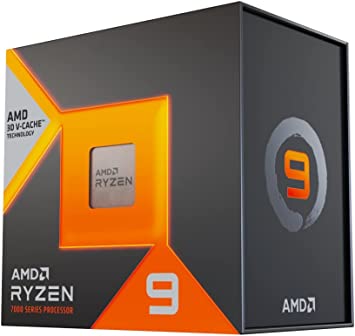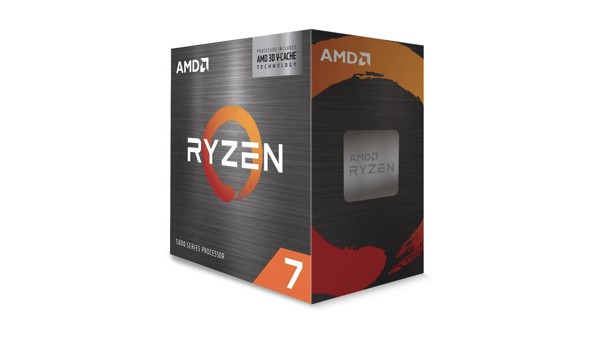Last Updated on
The new AMD Ryzen 9 7900X3D was a complete success at launch. According to the data, it sold 50% more than the normal 7900X, and it’s almost out of stock already. This proves how well-received AMD 3D V-cache technology has become, especially when combined with the new Zen 4 processors’ efficiency that provides a balance between gaming and productivity. That’s why the bout between the Ryzen 7 5800X3D vs Ryzen 9 7900X3D is an interesting matchup.
In this article, we will be conducting a comparison between these two popular processors, the Ryzen 7 5800X3D and the 7900X3D. We will be analyzing their specifications, performance, and pricing to determine the extent of AMD’s technological advancements and whether the 7900X3D is still worth its $599 price tag. Additionally, we will be giving the 5800X3D the recognition it deserves.
Ryzen 7 5800X3D vs 7900X3D: Specs
The Ryzen 9 7900X3D is built on a newer Zen 4 architecture and is manufactured on a smaller TSCM 5nm process node compared to the Ryzen 7 5800X3D’s Zen 3 architecture and TSCM 7nm process node. This new architecture makes it easy for the manufacturing process to add more efficient and faster cores.
Thanks to the new architecture the new Ryzen 9 7900X3D has more cores and threads than the Ryzen 7 5800X3D, with 12 cores and 24 threads compared to the Ryzen 7’s 8 cores and 16 threads. AMD aims to improve the X3D line’s productivity efficiency.
In terms of clock speeds, the Ryzen 9 7900X3D has a higher base frequency of 4.4 GHz and a higher boost clock speed of 5.6 GHz compared to the Ryzen 7 5800X3D’s base frequency of 3.4 GHz and boost clock speed of 4.5 GHz.
| Specs | Ryzen 9 7900X3D | Ryzen 7 5800X3D |
|---|---|---|
| Architecture | Zen 4 | Zen 3 |
| Process node | TSCM 5nm | TSCM 7 nm |
| Cores/Threads | 12 / 24 | 8 / 16 |
| Frequency | 4.4GHz | 3.4 GHz |
| Boost clock speed | 5.6GHz | 4.5 GHz |
| Socket | Socket AM5 | Socket AM4 |
| Cache L3 | 128MB | 96 MB |
| TDP | 120W | 105W |
| Launch MSRP | $599 | $499 |
The Ryzen 9 7900X3D requires the newer Socket AM5, while the Ryzen 7 5800X3D is compatible with the older Socket AM4. This will, however, make the accessibility to the technology more expensive, but the performance return is worth it. Additionally, the Ryzen 9 7900X3D has a larger L3 cache of 128 MB compared to the Ryzen 7 5800X3D’s 96 MB.
Another improvement is the L3 cache. Although both CPUs exist thanks to the 3D V-cache technology the 7900X3D started out from a better spec CPU with more cache from the beginning, so the new technology ended up adding to a better cache total.
This all comes with a price; the Ryzen 9 7900X3D has a higher TDP of 120W compared to the Ryzen 7 5800X3D’s 105W. This means that the Ryzen 9 7900X3D will require a higher quality power supply and better cooling solutions to maintain stable performance.
Overall, the Ryzen 9 7900X3D offers better performance and newer technology compared to the Ryzen 7 5800X3D, but it also comes with a higher price tag. The Ryzen 7 5800X3D offers a more affordable option with still solid performance for those on a tighter budget.
Ryzen 7 5800X3D vs 7900X3D: Performance
The Ryzen 7 5800X3D and Ryzen 9 7900X3D are two powerful CPUs with impressive capabilities in different areas. While the 5800X3D is known for its remarkable gaming performance, the 7900X3D surpasses it in terms of overall performance.
One of the reasons for this is the Zen 4 core architecture used in the 7900X3D, which is significantly more powerful than the Zen 3 core found in the 5800X3D. The Zen 4 core boasts enormous IPC (Instructions Per Cycle) improvements that are highly beneficial for single-core workloads like gaming, making the 7900X3D a top choice for gamers who demand high performance.
Moreover, thanks to this new architecture, the 7900X3D is more capable of performing multi-threaded tasks, making it a more competitive CPU in productivity against other CPUs such as the i9-13900K. This makes it a top choice for professionals who require high processing power for demanding applications like video editing, 3D rendering, and scientific computing.
Another key advantage of the 7900X3D over the 5800X3D is its unlocked feature, which allows for automatic overclocking. This means that the 7900X3D is not as limited as the 5800X3D, and users can achieve significant performance gains with the 7900X3D in gaming workloads compared to the 5800X3D.
Finally, the cache also plays a crucial role in gaming performance, and the 7900X3D has a much-improved cache with a larger capacity. With 128MB of L3 cache compared to the 96MB found in the 5800X3D, users can expect a boost in gaming performance with the 7900X3D.
Overall, while the Ryzen 7 5800X3D is an excellent CPU for gamers, the Ryzen 9 7900X3D is a more versatile CPU that offers superior performance in gaming, productivity, and multi-threaded workloads.
Ryzen 7 5800X3D vs 7900X3D: Price
The Ryzen 9 7900X3D has a higher launch MSRP of $599 compared to the Ryzen 7 5800X3D’s $499 launch MSRP. This difference in price can be attributed to the Ryzen 9’s higher core count, clock speed, cache size, and architectural improvements over the Ryzen 7.
While the price difference may be a consideration for budget-conscious consumers, it’s important to note that the performance gains and benefits of the Ryzen 9 may justify the extra cost for some users, particularly those who require more powerful processing capabilities for demanding tasks such as video editing, rendering, or scientific computing.
Ryzen 7 5800X3D vs 7900X3D: Conclusion
Both the Ryzen 7 5800X3D and Ryzen 9 7900X3D are powerful CPUs with their own strengths and weaknesses. The 5800X3D is an excellent choice for gaming with impressive performance, but the 7900X3D outperforms it in both single and multi-threaded tasks, making it a more versatile and competitive CPU in productivity tasks.
Additionally, the 7900X3D’s larger cache size and unlocked automatic overclocking feature make it a better choice for those looking to get the most out of their gaming workloads. However, the higher price point of the 7900X3D may not be feasible for everyone, and the 5800X3D is a more budget-friendly option that still delivers impressive gaming performance. Ultimately, the choice between the two CPUs will depend on individual needs and budget.





